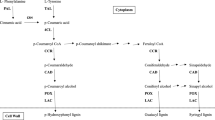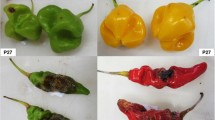Abstract
The kernel pericarp of a maize (Zea mays L.) inbred, Mp313E, that browns rapidly at milk stage when damaged and that is resistant toAspergillus flavus Link and the dusky sap beetleCarpophilus lugubris Murray compared to a susceptible inbred, SC212M, was examined for differing oxidizing enzymes (peroxidases) and their substrate specificity. Additional pericarp enzymes were constitutively produced by the Mp313E inbred compared to the SC212M inbred, as indicated by gel electrophoresis and isoelectric focusing. These enzymes oxidized relevent pericarp substrates such as ferulic acid. Similar results were seen with two varieties of maize containing theCh mutant gene, which brown upon senescence in that enhanced oxidation of ferulic acid was seen in homogenates of browned pericarp compared to that which was cold-shocked and did not brown. Corn powder that was browned by mixing oxidizing enzymes with corn pericarp components ferulic acid and coumaric acid were typically less preferred/more toxic to caterpillars such asHelicoverpa zea (Boddie) and sap beetles such asC. lugubris. Thus, enhanced browning of maize pericarp can promote resistance to insects and is at least partly influenced by the presence of oxidizing enzymes. This mechanism may also promote resistance to maize pathogens, including those that produce mycotoxins.
Similar content being viewed by others
References
Assabgui, R.A., Reid, L.M., Hamilton, R.I., andArnason, J.T. 1993. Correlation of kernel (E)-ferulic acid content of maize with resistance toFusarium graminearum.Phytopathology 83:949–953.
Barz, W., andHoesel, W. 1978. Metabolism and degradation of phenolic compounds in plants.Recent Adv. Phytochem. 12:339–369.
Bilgrami, K.S., Sinha, K.K., andSingh, P. 1981. Inhibition of aflatoxin production by ferulic acid on some cereals and oil seeds.Curr. Sci. 50:997–998.
Bio-Rad. 1976. Protein assay. Bio-Rad Corp., Richmond, California.
Brad, I., Terbea, M., Marcu, Z., andHurduc, N. 1974. Influenta infectarii cuFusarium moniliforme Scheid a unor linii si hibrizi de porumb, asupra spectrului izoenzimelor peroxidazice.Stud. Cerret. Biochim. 17:11–14.
Brewbaker, J.L., andHasegawa, Y. 1975. Polymorphisms of the major peroxidases of maize, pp. 659–673,in C.L. Markert (ed.). Isozymes III. Developmental Biology. Academic, New York.
Brewbaker, J.L., Nagai, C., andLiu, E.H. 1985. Genetic polymorphisms of 13 maize peroxidases.J. Hered. 76:159–167.
Byrde, R.J.W., Fielding, A.H., andWilliams, A.H. 1960. The role of oxidized polyphenols in the varietal resistance of apples to brown rot, pp. 95–99,in J.B. Pridham (ed.). Phenolics in Plants in Health and Disease. Pergamon Press, New York.
Byrne, P.F., Darrah, L.L., Simpson, K.B., Keaster, A.J., Barry, B.D., andZuber, M.S. 1989. Maize silk pH as an indicator of resistance to the com earworm (Lepidoptera: Noctuidae).Environ. Entomol. 18:356–360.
Campa, A. 1991. Biological roles of plant peroxidases: Known and potential function, pp. 25–50,in J. Everse, K.E. Everse, and M.B. Grisham (eds.). Peroxidases in Chemistry and Biology, Vol. II. CRC Press, Boca Raton, Florida.
Cardena-Gomez, G.C., andNicholson, R.L. 1987. Papilla formation and associated peroxidase activity: A non-specific response to attempted fungal penetration of maize.Physiol. Mol. Plant Pathol. 31:51–67.
Chen, J.S., Wei, C., Rolle, R.S., Otwell, W.S., Balaban, M.O., andMarshall, M.R. 1991. Inhibitory effect of kojic acid on some plant and crustacean polyphenol oxidases.J. Agric. Food. Chem. 39:1396–1401.
Classen, D., Arnason, J.T., Serratos, J.A., Lambert, J.D.H., Nozzolillo, C., andPhilocéne, B.J.R. 1990. Correlation of phenolic acid content of maize to resistance toSitophilus zeamais, the maize weevil, in CIMMYT's collections.J. Chem. Ecol. 16:301–315.
Coley, P.D. 1983. Herbivory and defensive characteristics of tree species in a lowland tropical forest.Ecol. Monogr. 53:209–233.
Conyers, S.M., andKidwell, D.A. 1991. Chromogenic substrates for horseradish peroxidase.Anal. Biochem. 192:207–211.
Dowd, P.F. 1988. Toxicological and biochemical interactions of the fungal metabolites fusaric acid and kojic acid with xenobiotics inHeliothis zea (F.) andSpodoptera frugiperda (J.E. Smith).Pestic. Biochem. Physiol. 32:123–134.
Dowd, P.F. 1990. Responses ofCarpophilus hemipterus larvae and adults to selected secondary metabolites of maize.Entomol. Exp. Appl. 54:29–36.
Dowd, P.F. 1992. Corn kernel aryl alcohol oxidases as cross-resistance mechanisms for fungi and insects. Abstract AGRO-107,in Abstracts of the 203rd meeting of the American Chemical Society, Washington, DC.
Dowd, P.F. 1994. Examination of anAspergillus flavus resistant inbred of maize for cross-resistance to sap beetle vectors.Entomol. Exp. Appl. 77:177–180.
Dowd, P.F., andLagrimini, L.M. 1994. Tissues of transgenic flowering tobacco and tomato overexpressing tobacco anionic peroxidase are resistant to insects. Submitted.
Dowd, P.F., andNorton, R.A. 1995. Browning-associated mechanisms of resistance to insects in com callus tissue. Submitted.
Dowd, P.F., andSparks, T.C. 1986. Characterization of atrans-permethrin hydrolyzing enzyme fromPseudoplusia includens.Pestic. Biochem. Physiol. 25:73–81.
Dowd, P.F., andVega, F.E. 1995. Arylalcohol oxidase generated products of allelochemicals as potential resistance mechanism against insects: Effects on the com leafhopperDalbulus maidis. Submitted.
Dowd, P.F., andWeber, C.M. 1991. A labor-saving method for rearing a corn sap beetle,Carpophilus freemani Dobson (Coleoptera: Nitidulidae) on pinto bean-based diet.J. Agric. Entomol. 8:149–153.
Dowd, P.F., Bartelt, R.J., andWicklow, D.T. 1992. Novel insect trap useful in capturing sap beetles and other flying insects.J. Econ. Entomol. 85:772–778.
Espelie, K.E., Franceschi, V.R., andKolattukudy, P.E. 1986. Immunocytochemical localization and time course of appearance of an anionic peroxidase associated with suberization in wound-healing potato tuber tissue.Plant Physiol. 81:487–492.
Evershed, R.P., Spooner, N., Prescott, M.C., andGoad, L.J. 1988. Isolation and characterization of intact steryl ferulates from seeds.J. Chromatogr. 440:23–35.
Felton, G.W., Donato, K.K., del Vecchio, R.J., andDuffey, S.S. 1989. Activation of plant polyphenol oxidases by insect feeding damage reduces the nutritive quality of foliage.J. Chem. Ecol. 15:2667–2694.
Felton, G.W., Donato, K.K., Broadway, R.M., andDuffey, S.S. 1992. Impact of oxidized plant phenolics on the nutritional quality of dietary protein to a noctuid herbivore,Spodoptera exigua.J. Insect Physiol. 38:277–285.
Fry, S.C. 1979. Phenolic components of the primary cell wall and their possible role in the hormonal regulation of growth.Planta 146:343–351.
Fry, S.C. 1982. Isodityrosine, a new cross-linking amino acid from plant cell-wall glycoprotein.Biochem. J. 204:449–455.
Fry, S.C. 1986. Polymer-bound phenols as natural substrates of peroxidases, pp. 169–181,in H. Greppin, C. Penel, and T. Gaspar (eds.). Molecular and Physiological Aspects of Plant Peroxidases. University of Geneva, Switzerland.
Gaspar, T., Penel, C., Thorpe, T., andGreppin, H. 1982. Peroxidases: 1970–1980: A Survey of their Biochemical and Physiological Roles in Higher Plants. Université de Geneve, Centre de Botanique, Geneva, Switzerland, 323 pp.
Gatehouse, A.M.R., Howe, D.S., Flemming, J.E., Hilder, V.A., andGatehouse, J.A. 1991. Biochemical basis of insect resistance in winged bean (Psophocarpus tetragonolobus) seeds.J. Sci. Food Agric. 55:63–74.
Gomez, L.A., Rodriguez, J.G., Poneleit, C.G., andBlake, D.F. 1983. Relationship between some characteristics of the corn kernel pericarp and resistance to the rice weevil (Coleoptera: Curculionidae).J. Econ. Entomol. 76:797–800.
Harris, P.J., andHartley, R.D. 1970. Detection of bound ferulic acid in cell walls of the Graminae by ultraviolet fluorescence microscopy.Nature 259:508–510.
Hilder, V.A., Gatehouse, A.M.R., Sheerman, S.E., Barker, R.F., andBoulter, D. 1987. A novel mechanism of insect resistance engineered into tobacco.Nature 330:160–163.
Hood, E.E., Hood, K.R., andFritz, S.E. 1991. Hydroxyproline-rich glycoproteins in cell walls of pericarp from maize.Plant Sci. 79:12–22.
Kahl, G. 1974. Metabolism in plant storage tissue slices.Bot. Rev. 40:263–314.
Kato, Y., andNevins, D.J. 1985. Isolation and identification ofO-(5-O-feruloyl-l-arabinofuranosyl)-(1–3)-O-Β-d-xylopyranosyl-(1–4)-d-xylopyranose as a component ofZea shoot cell walls.Carbohydr. Res. 137:139–150.
Kojima, S. 1931. Studies on peroxidase. II. The effect of peroxidase on the bactericidal action of phenols.J. Biochem. (Tokyo) 14:95–109.
Kollmorgan Instruments Corp. 1992. Munsell Soil Charts. Kollmorgan Instruments Corp., Newburg, NY.
Lagrimini, L.M., Vaughn, J., Erb, W.A., andMiller, S.A. 1993. Peroxidase overproduction in tomato: wound-induced polyphenol deposition and disease resistance.HortSci. 28:218–221.
Lee, C.Y. 1992. Enzymatic oxidation of phenolic compounds in fruits, pp. 305–319,in C.T. Ho, C.Y. Lee, and M.T. Huang (eds.). Phenolic Compounds in Food and Their Effects on Health. I. Analysis, Occurrence, and Chemistry. American Chemical Society, Washington, D.C.
Macri, F., DiLenna, P., andVianello, A. 1974. Preliminary research on peroxidase, polyphenol oxidase, and phenol content in healthy and infected com leaves, susceptible and resistant toHelminthosporium maidis race T.Riv. Pathol. Veg. Ser. 4. 10:109–121.
Markwalder, H.-O., andNeukom, H. 1976. Diferulic acid as a possible crosslink in hemicelluloses from wheat germ.Phytochemistry 15:836–837.
McCallum, J.A., andWalker, J.R.L. 1991. Phenolic biosynthesis during grain development in wheat (Triticum aestivum L.) III. Changes in hydroxycinnamic acids during grain development.J. Cereal Sci. 13:161–172.
Miles, P.W., andOertli, J.J. 1993. The significance of antioxidants in aphid-plant interactions: The redox hypothesis.Entomol. Exp. Appl. 67:275–283.
Neuffer, M.G., Jones, L., andZuber, M.S. 1969. The Mutants of Maize. Crop Science Society of America, Madison, Wisconsin.
Norton, R.A. 1994. Isolation and identification of steryl cinnamic acid derivatives from corn bran.Cereal Chem. 71:111–117.
O'Connel, R.J., Brown, I.R., Mansfield, J.W., Bailey, J.A., Mazau, D., Rumeau, D., andEsquerre-Tugaye, M.T. 1990. Immunocytochemical localization of hydroxyproline-rich glycoproteins accumulating in melon and bean at sites of resistance to bacteria and fungi.Mol. Plant Microbe Interactions 3:33–40.
Ohashi, H., Yamamoto, E., Lewis, N.G., andTowers, G.H.N. 1987. 5-hydroxyferulic acid inZea mays andHordeum vulgare cell walls.Phylochemistry 26:1915–1916.
Ohba, T., Murakami, H., andHara, S. 1971. Identification ofl-dopa and protocatechuic acid as main precursor of pigment of brown rice-koji.Agric. Biol. Chem. 35:674–681.
Pickering, J.W., Powell, B.L., Wender, S.H., andSmith, E.C. 1973. Ferulic acid: A substrate for two isoperoxidases fromNicotiana tabacum tissue cultures.Phytochemistry 12:2639–2643.
Ralph, J., andHelm, R.F. 1993. Lignin/hydroxycinnamic acid/polysaccharide complexes: synthetic models for regiochemical characterization, pp. 201–246,in H.G. Jung, D.R. Buxton, R.D. Hatfield, and J. Ralph (eds.). Forage Cell Wall Structure and Digestibility. American Society of Agronomy, Madison, Wisconsin.
Raupp, M.J. 1985. Effects of leaf toughness on mandibular wear of the leaf beetle,Plagiodera versicolora.Ecol. Entomol. 10:73–79.
Reese, J.C. 1978. Chronic effects of plant allelochemicals on insect nutritional physiology.Entomol. Exp. Appl. 24:425–431.
Riley, R.G., andKolattukudy, P.E. 1975. Evidence for covalently attachedp-coumaric acid and ferulic acid in cutins and suberins.Plain Physiol. 56:650–654.
Schloss, P., Walter, C., andMÄder, M. 1987. Basic peroxidases in isolated vacuoles ofNicotiana tabacum L. Planta 170:225–229.
Scott, G.E., andZummo, N. 1988. Sources of resistance in maize to kernel infection byAspergillus flavus in the field.Crop Sci. 28:504–507.
Seitz, L.M. 1989. Stanol and sterol esters of ferulic andp-coumaric acids in wheat, corn, rye and triticale.J. Agric. Food Chem. 37:662–667.
Serratos, A., Arnason, J.T., Nozzolillo, C., Lambert, J.D.H., Philogéne, B.J.R., Fulcher, G., Davidson, K., Peacock, L., Atkinson, J., andMorand, P. 1987. Factors contributing to resistance of exotic maize populations to maize weevil,Silophilus zeamaiz.J. Chem. Ecol. 13:751–762.
Steffens, J.C., andWaters, D.S. 1991. Biochemical aspects of glandular trichome-mediated insect resistance in theSolanaceae, pp. 136–149,in P.E. Hedin (ed.). Naturally Occurring Pest Bioregulators. American Chemical Society, Washington, D.C.
Tracy, W.F., andSchmidt, D.H. 1987. Effect of endosperm type on pericarp thickness in sweet corn inbreds.Crop. Sci. 27:692–694.
Turner, W.F., andAldridge, D.C. 1983. Fungal Metabolites II. Academic Press, New York.
Urbanska, A., andLeszczynski, B. 1992. Biochemical adaptations of cereal aphids to host plants, pp. 277–299,in S.B.J. Menken, J.H. Visser, and P. Harrewijn. (eds.). Proceedings, 8th International Symposium on Insect-Plant Relationships. Kluwer Academic, Dordrecht, The Netherlands.
Urs, N.V.R., andDunleavy, J.M. 1975. Enhancement of the bactericidal activity of a peroxidase system by phenolic compounds.Phytopathology 65:686–690.
Vance, C.P., Anderson, J.O., andSherwood, R.T. 1976. Soluble and cell wall peroxidases in reed canarygrass in relation to disease resistance and localized lignin formation.Plant Physiol. 57:920–922.
Vance, C.P., Kirk, T.K., andSherwood, R.T. 1980. Lignification as a mechanism of disease resistance.Annu. Rev. Phytopathol. 18:259–288.
van Huystee, R.B.V., andZheng, X. 1993. Cationic peanut peroxidase and the oxidation of ferulic acid.Phytochemistry 34:933–939.
van Loon, L.C. 1971. Tobacco polyphenoloxidases: A specific staining method indicating nonidentity with peroxidases.Phytochemistry 10:503–507.
Waiss, A.C., Chan, B.G., Elliger, C.A., Wiseman, B.R., McMillian, W.W., Widstrom, N.W., Zuber, M.S., andKeaster, A.J. 1979. Maisin, a flavone glycoside from com silks with antibiotic activity toward corn earworm.J. Econ. Entomol. 72:256–258.
Wiseman, B.R., andIsenhour, D.J. 1993. Interaction of diet ingredients with levels of silk of a corn genotype resistant to corn earworm (Lepidoptera: Noctuidae).J. Econ. Entomol. 86:1291–1296.
Author information
Authors and Affiliations
Rights and permissions
About this article
Cite this article
Dowd, P.F. Enhanced maize (Zea mays L.) pericarp browning: Associations with insect resistance and involvement of oxidizing enzymes. J Chem Ecol 20, 2777–2803 (1994). https://doi.org/10.1007/BF02098389
Received:
Accepted:
Issue Date:
DOI: https://doi.org/10.1007/BF02098389




